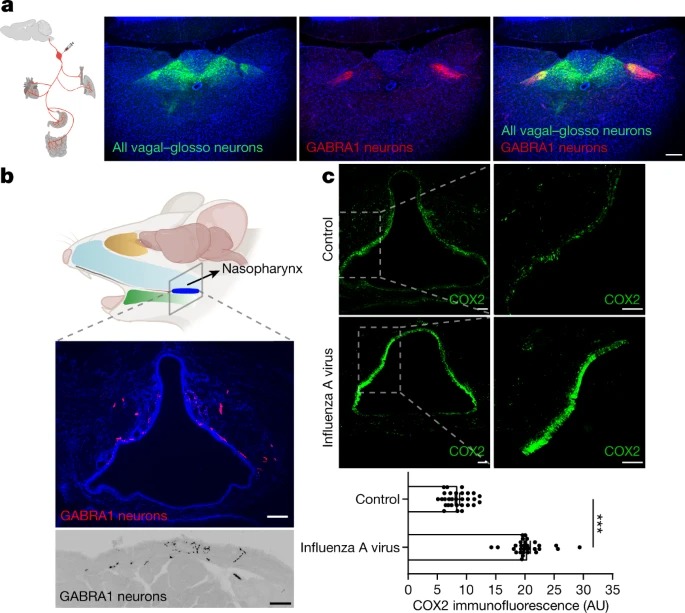airway-to-brain sensory pathway는influenza-induced sickness를 중재한다.

Abstract
Pathogen infection은 신경적으로 조정된 행동 및 생리적 변화를 수반하는 정형화된 상태의 질병을 유발한다. 감염 시 immune cell은 cytokine과 다른 mediators의 ‘storm’을 방출하며, 이들 중 많은 것은 뉴런에 의해 감지된다. 그러나 naturalistic infection 동안 sickness behaviour을 유발하는 반응하는 neural circuit 및 neuro–immune interaction 메커니즘은 아직 명확하지 않다. aspirin 과 ibuprofen과 같은 처방전 없이 살 수 있는 약물은 질병을 완화하고 prostaglandin E2(PGE2) 합성을 차단함으로써 작용하기 위해 널리 사용된다. 대표적인 모델은 PGE2가 blood–brain barrier를 넘어 hypothalamic neuron과 직접적으로 결합한다는 것이다.
여기서 peripheral sensory neuron atlas를 광범위하게 다루는 유전적 도구를 사용하여, 대신 쥐의 nfluenza-induced sickness behaviour에 필수적인 소수의 PGE2-detecting glossopharyngeal sensory neuron(petrosal GABRA1 neurons)을 식별했다. 이러한 뉴런에서 petrosal GABRA1 뉴런을 제거하거나 PGE2 receptor 3(EP3)의 targeted knockout을 통해 인플루엔자로 인한 음식 섭취, 수분 섭취 및 초기 감염 시 mobility 감소를 제거하고 생존을 향상시킨다. 유전적으로 유도된 anatomical mapping은 petrosal GABRA1 뉴런이 감염 후 cyclooxygenase-2의 발현이 증가한 nasopharynx의 mucosal 영역에 투영하고, brainstem에서 axonal targeting pattern을 보인다는 것을 밝혀냈다. 이러한 발견은 국소적으로 생성된 prostaglandins을 감지하고 호흡기 바이러스 감염에 대한 전신 질환 반응을 매개하는 primary airway-to-brain sensory pathway를 보여준다.
